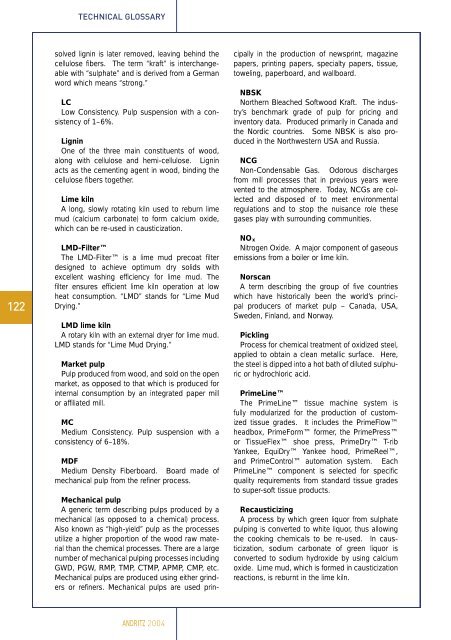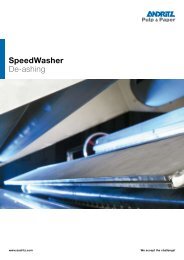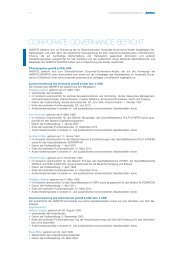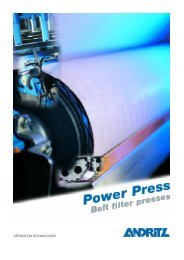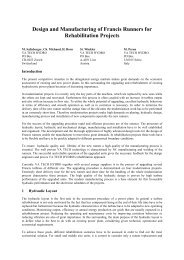2004 - ANDRITZ Vertical volute pumps
2004 - ANDRITZ Vertical volute pumps
2004 - ANDRITZ Vertical volute pumps
Create successful ePaper yourself
Turn your PDF publications into a flip-book with our unique Google optimized e-Paper software.
122<br />
TECHNICAL GLOSSARY<br />
solved lignin is later removed, leaving behind the<br />
cellulose fibers. The term “kraft” is interchangeable<br />
with “sulphate” and is derived from a German<br />
word which means “strong.”<br />
LC<br />
Low Consistency. Pulp suspension with a consistency<br />
of 1–6%.<br />
Lignin<br />
One of the three main constituents of wood,<br />
along with cellulose and hemi-cellulose. Lignin<br />
acts as the cementing agent in wood, binding the<br />
cellulose fibers together.<br />
Lime kiln<br />
A long, slowly rotating kiln used to reburn lime<br />
mud (calcium carbonate) to form calcium oxide,<br />
which can be re-used in causticization.<br />
LMD-Filter<br />
The LMD-Filter is a lime mud precoat filter<br />
designed to achieve optimum dry solids with<br />
excellent washing efficiency for lime mud. The<br />
filter ensures efficient lime kiln operation at low<br />
heat consumption. “LMD” stands for “Lime Mud<br />
Drying.”<br />
LMD lime kiln<br />
A rotary kiln with an external dryer for lime mud.<br />
LMD stands for “Lime Mud Drying.”<br />
Market pulp<br />
Pulp produced from wood, and sold on the open<br />
market, as opposed to that which is produced for<br />
internal consumption by an integrated paper mill<br />
or affiliated mill.<br />
MC<br />
Medium Consistency. Pulp suspension with a<br />
consistency of 6–18%.<br />
MDF<br />
Medium Density Fiberboard. Board made of<br />
mechanical pulp from the refiner process.<br />
Mechanical pulp<br />
A generic term describing pulps produced by a<br />
mechanical (as opposed to a chemical) process.<br />
Also known as “high-yield” pulp as the processes<br />
utilize a higher proportion of the wood raw material<br />
than the chemical processes. There are a large<br />
number of mechanical pulping processes including<br />
GWD, PGW, RMP, TMP, CTMP, APMP, CMP, etc.<br />
Mechanical pulps are produced using either grinders<br />
or refiners. Mechanical pulps are used prin-<br />
<strong>ANDRITZ</strong> <strong>2004</strong><br />
cipally in the production of newsprint, magazine<br />
papers, printing papers, specialty papers, tissue,<br />
toweling, paperboard, and wallboard.<br />
NBSK<br />
Northern Bleached Softwood Kraft. The industry’s<br />
benchmark grade of pulp for pricing and<br />
inventory data. Produced primarily in Canada and<br />
the Nordic countries. Some NBSK is also produced<br />
in the Northwestern USA and Russia.<br />
NCG<br />
Non-Condensable Gas. Odorous discharges<br />
from mill processes that in previous years were<br />
vented to the atmosphere. Today, NCGs are collected<br />
and disposed of to meet environmental<br />
regulations and to stop the nuisance role these<br />
gases play with surrounding communities.<br />
NOx<br />
Nitrogen Oxide. A major component of gaseous<br />
emissions from a boiler or lime kiln.<br />
Norscan<br />
A term describing the group of five countries<br />
which have historically been the world’s principal<br />
producers of market pulp – Canada, USA,<br />
Sweden, Finland, and Norway.<br />
Pickling<br />
Process for chemical treatment of oxidized steel,<br />
applied to obtain a clean metallic surface. Here,<br />
the steel is dipped into a hot bath of diluted sulphuric<br />
or hydrochloric acid.<br />
PrimeLine<br />
The PrimeLine tissue machine system is<br />
fully modularized for the production of customized<br />
tissue grades. It includes the PrimeFlow<br />
headbox, PrimeForm former, the PrimePress<br />
or TissueFlex shoe press, PrimeDry T-rib<br />
Yankee, EquiDry Yankee hood, PrimeReel,<br />
and PrimeControl automation system. Each<br />
PrimeLine component is selected for specific<br />
quality requirements from standard tissue grades<br />
to super-soft tissue products.<br />
Recausticizing<br />
A process by which green liquor from sulphate<br />
pulping is converted to white liquor, thus allowing<br />
the cooking chemicals to be re-used. In causticization,<br />
sodium carbonate of green liquor is<br />
converted to sodium hydroxide by using calcium<br />
oxide. Lime mud, which is formed in causticization<br />
reactions, is reburnt in the lime kiln.


